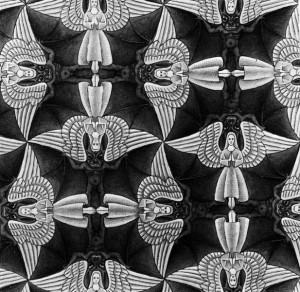 Recall from Part 2 that Escher reveals himself though his art.
Recall from Part 2 that Escher reveals himself though his art.
From 1920 to 1927 we find at least 11 Escher prints with Biblical themes. Nine prints depict themes from the book of Genesis. A tenth print is entitled the Scapegoat. Escher made the Scapegoat print for a booklet written by his friend Aad van Stolk. This print incorporates both Old and New Testament themes by portraying the devil, the scapegoat, and the Christ.
In 1935 Escher created the print Hell. Hell copies a portion of the painting The Garden of Earthly Delights. The Garden of Earthly Delights, painted by Hieronymus Bosch in approximately 1500, has three panels. The left panel depicts paradise, the right panel depicts Hell. Escher has chosen perhaps the most interesting portion of Bosch’s Hell, ‘The Tree Man’, and recreated it.
Now we move into Escher’s tessellation phase. In 1941 Escher again returns to the theme of Heaven and Hell by creating a plane filled with a repeating motif of angels and devils. As Escher states, this motif was symbolic of Heaven and Hell and it becomes a theme he will return to over and over.
A year later, Escher carved this angel-devil motif into a wooden sphere. In a letter to C. V. S. Roosevelt Escher wrote: “It has two poles and an equator. One pole represents ‘heaven,’ with only white angels on a black background, which I carved much deeper than the angel figures. The other pole shows ‘hell,’ with only black devils on a deeply carved white background. At the equator both angles and devils are visible and equivalent, carved at the same sphere-level.”
On the topic of heaven and hell, Escher writes: “For this reason, as long as there have been men to lie and sit and stand upon this globe, or to crawl and walk upon it, to sail and ride and fly across it (and fly off it), we have held firmly to the notion of a hereafter, purgatory, heaven, hell, rebirth and nirvana, all of which must continue to be everlasting in time and infinite space.”
In Escher, we find recognition of life after death, and of the infinite.
From 1942 onward we begin to see in Escher’s compositions the emergence of both the circular form and the sphere. They appear in the context of a mature artist seeking to capture the infinite in his work. These are Escher’s mandalas, and they give us greater insight into his thought and beliefs. We begin to look at them in part 4.
(Note on art. Throughout this blog I am using Escher’s artwork unless otherwise noted. Escher’s art is still under copyright. I am claiming fair use. My rationale is that I am only using low resolution copies of Escher’s art. The images are readily available on the internet. The images are being used for educational purposes. My intent is to avoid detracting from the value of Escher’s original prints.)
